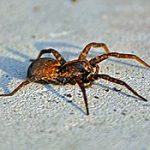Wolf spiders are members of the family Lycosidae, from the Ancient Greek word “λÏκος” meaning “wolf”. They are robust and agile hunters with good eyesight. They live mostly solitary lives and hunt alone. Some are opportunistic hunters pouncing upon prey as they find it or even chasing it over short distances. Some will even wait for passing prey in or near the mouth of a burrow.
Their eyes reflect light well, allowing someone with a flashlight to easily hunt for them at night. Flashing a beam of light over the spider will produce eyeshine. The light from the flashlight has been reflected from the spider’s eyes directly back toward its source, producing a “glow” that is easily noticed. This is also especially helpful because the wolf spiders are nocturnal and will be out hunting for food, making it easier to find them.
Because they depend on camouflage for protection, they do not have the flashy appearance of some other kinds of spiders. In general their coloration is appropriate to their favorite habitat.
There are many smaller wolf spiders. They live on pastures and fields and are an important natural control on harmful insects.
Wolf spiders are capable of defensive bites, and some South American species may give bites that are medically significant. However, in general their presence works in favor of humans because they consume insects.
Wolf spiders will inject venom freely if continually provoked. Symptoms of their venomous bite include swelling, mild pain and itching. Though usually considered harmless to humans, the bite of some species may be painful. In the past, necrotic bites have been attributed to some South American species, but further investigation has indicated that those problems that did occur were probably actually due to bites by members of other genera. Australian wolf spiders have also been associated with necrotic wounds, but careful study has likewise shown them not to produce such results.
Wolf spiders can be found in a wide range of habitats both coastal and inland. These include shrublands, woodland, wet coastal forest, alpine meadows, and suburban gardens. Spiderlings disperse aerially and consequently wolf spiders have wide distributions. Although some species have very specific microhabitat needs (such as stream-side gravel beds or montane herb-fields) most are wanderers without permanent homes. Some build burrows which can be opened or have a trapdoor. Arid zone species construct turrets or plug their holes with leaves and pebbles during the rainy season to protect themselves from flood waters.

